Non La Vietnam: Explore The Traditional Vietnamese Hat

Table of Contents
1. Some facts about Non la: traditional Vietnamese hat
a. Origin of conical hat
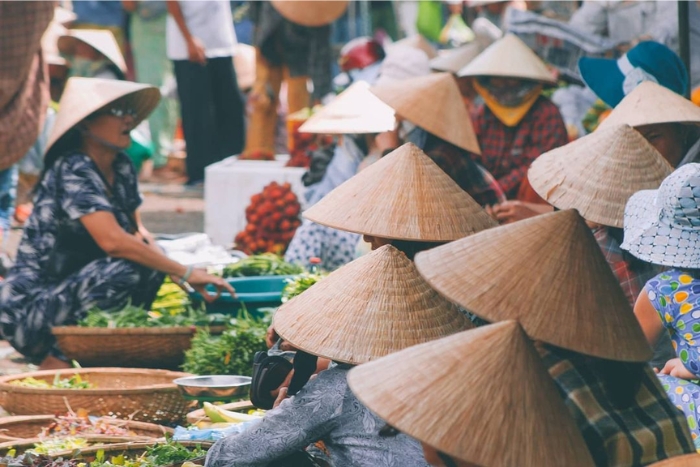
Have you ever pondered the origins of traditional Vietnamese hats? Like other cultural symbols, the conical hat also carries its own special story. According to an ancient Vietnamese legend, there was once a prolonged and harsh typhoon season that brought relentless rain for weeks, causing widespread devastation across the land.
As the people began to lose hope, a goddess descended from the heavens, wearing an enormous hat made of four giant leaves and bamboo sticks. This large conical hat shielded the Vietnamese people from the raging storm. The goddess not only cleared away the clouds and rain but also taught the people how to cultivate important crops like rice.

For thousands of years, nón lá has been worn and remains an enduring symbol of Vietnam.
b. Cultural signification
A symbol of Vietnamese heritage, non la embodies the nation's agricultural roots and is worn by all, from farmers to women in áo dài, representing the resilience and simplicity of the Vietnamese people.

Protection and practicality: The nón lá, made from lightweight and breathable materials like palm leaves and bamboo, provides essential protection from the sun and rain, making it a practical and indispensable accessory for those working outdoors in Vietnam's hot and humid climate.
Aesthetic and cultural elegance: beyond its practicality, Vietnamese hats symbolise grace and beauty, especially when paired with the Vietnamese traditional dress. Its shape and wear evoke a gentle femininity celebrated in Vietnamese poetry, music, and art.

Craftsmanship and tradition: The traditional vietnamese hat’s creation, a craft handed down through generations, reflects the artisans' skill and care. Each handmade hat embodies values of patience, diligence, and respect for nature.
The nón lá symbolises the hardworking spirit of the Vietnamese people, worn by labourers, fishermen, and farmers as a testament to their dedication and resilience.

2. Different types of nón lá through historical periods
There are several types of nón lá, with the most common being:
- Nón Gò Găng (nón ngựa) : From Bình Định Province, this sturdy hat was commonly worn by soldiers and labourers, valued for its durability and practicality in tough working conditions.
- Nón Quai Thao (also known as nón ba tầm): Popular in northern Vietnam,especially in the Red River River delta, this hat is known for its wide, flat shape and elegant strap. It was traditionally worn by women in the Red River Delta during festivals and folk performances, symbolising grace and femininity.

- Nón Thúng: Favoured in central Vietnam, particularly in the royal courts of the Nguyễn Dynasty, this basket-shaped hat is a refined design that reflects the sophistication of the imperial era.
- Nón bài thơ (Hue poem hat): thin, white conical hat with a picture or a few lines of poetry
- Nón gõ: A conical hat made of bamboo for soldiers in the past
- Nón khua: A round conical hat worn by servants of mandarins in the past
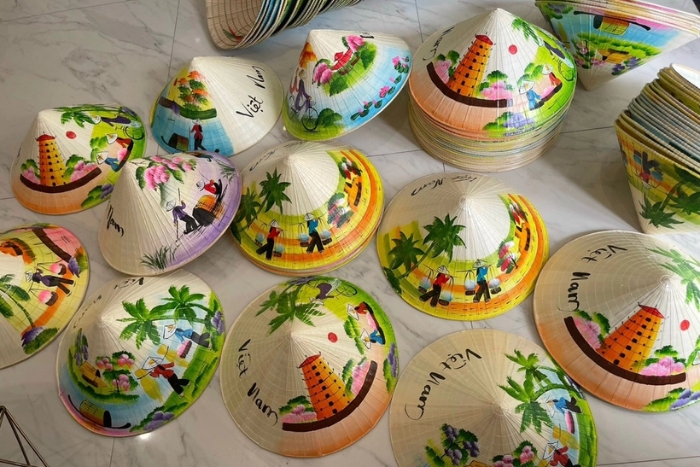
3. Which materials used and how to make traditional Vietnamese hat?
- Palm leaves: The leaves are dried in the sun until they turn white. They are then carefully selected to ensure they are of uniform size and thickness.
- Bamboo: Thin strips of bamboo are used to create the frame of the hat, providing structure and shape.
- Moc tree bark: This is sometimes used to bind the leaves to the bamboo frame, adding durability and a natural touch to the hat.
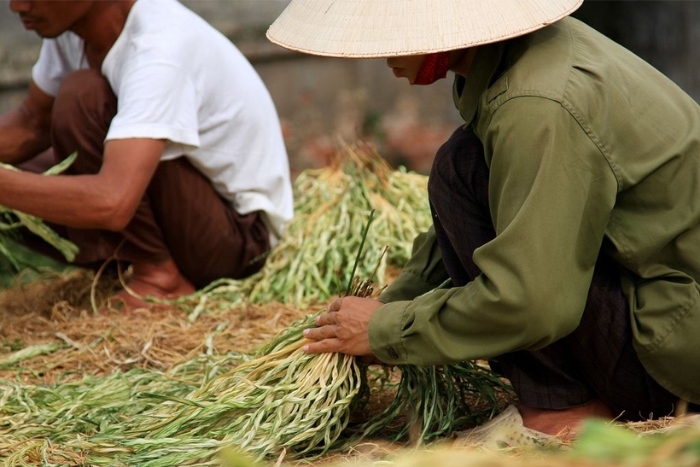
The creation of a conical hat is a meticulous process that requires skill, patience, and attention to detail. The process involves several steps, each essential to crafting a hat that is both functional and aesthetically pleasing.
Step 1: Selecting materials: The primary materials for a conical hat in Vietnam are palm leaves and bamboo. The palm leaves are harvested and dried in the sun until they turn white, which gives the hat its characteristic light colour. Bamboo is chosen for its flexibility and strength, used to create the hat's frame.

Step 2: Preparing the leaves: Once dried, the palm leaves are flattened and smoothed to ensure uniformity. Bad, damaged leaves are removed and the leaves are carefully stacked to form layers, usually 2-3 layers with about 20 - 30 leaves, depending on the desired thickness and durability.
Step 3: Constructing the frame: Thin bamboo strips are split and bent into a circular frame, forming the base of the hat, usually 16 thin bamboo strips for one hat. This frame is very important because it determines the shape and structure of the hat.

Step 4: Sewing the bamboo hat vietnam: The prepared palm leaves are then meticulously sewn onto the bamboo frame using fine threads, usually made from moc tree bark or silk. The leaves are layered and stitched in a spiral pattern, ensuring that the hat is waterproof and sturdy.
Step 5: Finishing the hat: After the leaves are securely attached, the excess material is trimmed, and the edges are neatly finished. Then cover the hat with oil several times and dry it in the sun to keep it beautiful and durable. Some hats may also include a silk or cotton chin strap, adding both comfort and a touch of elegance.
The entire process, from selecting materials to the final product, can take several days, depending on the complexity of the design. Each Vietnamese hat is a unique piece, reflecting the craftsmanship and cultural heritage of Vietnam.
4. Top reputable villages for making Nón Lá
While the conical hat is made throughout Vietnam, there are several villages renowned for their expertise and long-standing traditions in hat-making. Visiting these villages offers tourists a unique glimpse into the craftsmanship and cultural significance of the nón lá.
a. Chuong conical hat village, Hanoi
Located just 30 kilometres southwest of Hanoi, Chuông Village is perhaps the most famous for making bamboo hats vietnam in the north, one of the best Vietnam traditional craft villages. The village has been producing these hats for over 300 years, and nearly every household in Chuông is involved in the craft. Visitors to the village can witness the entire process, from selecting the materials to the final touches, and can even try their hand at making a hat themselves.

b. Phu Cam hat-making village, Hue
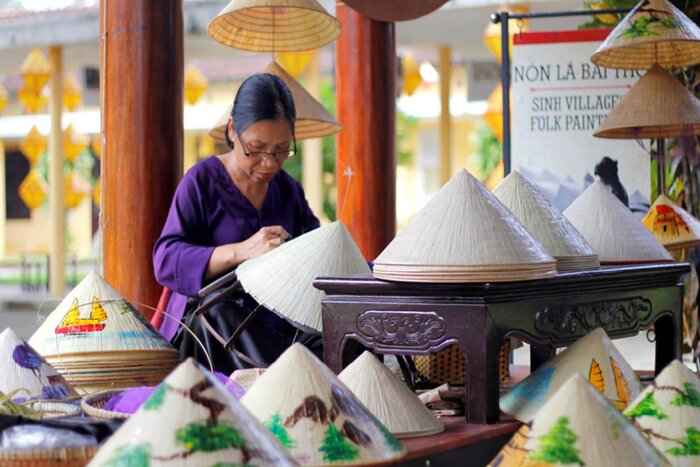
c. Tan Thoi conical hat village, An Giang
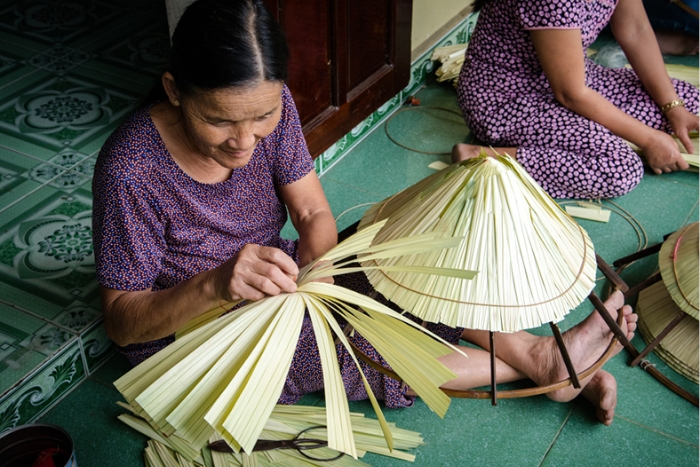
The Vietnamese hat is more than just a hat, it is a symbol of Vietnamese culture and a testament to the skill and artistry of the country's craftspeople. Whether you are exploring the bustling streets of Hanoi, the serene landscapes of Hue, or the vibrant Mekong Delta, you will find this iconic conical hat being worn by locals and available as a cherished souvenir. By visiting the villages where these nón lá are made, you not only gain insight into an ancient craft but also support the preservation of a vital part of Vietnam's cultural heritage.
>>> Vietnam travel itinerary 3 weeks
>>> Vietnam Tour 17 days
>>> Vietnam Vacation 18 days
>>> Vietnam Tour 21 days
>>> Vietnam Travel packages
The Vietnamese traditional hat is often worn during traditional festivals, cultural performances, and ceremonies such as weddings. It is also commonly worn during visits to temples or pagodas, as well as in rural areas during the Tet holiday (Lunar New Year).
To care for a non la vietnam, keep it dry and clean by wiping it with a damp cloth. Avoid exposing it to extreme heat or moisture for extended periods, as this can damage the leaves and frame. Store it in a cool, dry place when not in use.
Related travel guide
Other similar articles
CUSTOMIZABLE BY LOCAL EXPERTS
Personalized trip at the original price!
REFUND GUARANTEE
We believe in our work and promise to give you money back.
GOOD PRICE / QUALITY
95% satisfied more than expected!
24/7 LOCAL SUPPORT
We are always available online to provide assistance at any time.
Most read articles
Autour Asia is highly recommended on
Embracing the mission of "Satisfied more than expected" and providing authentic experiences, we have received numerous recommendations on reputable travel forums:























